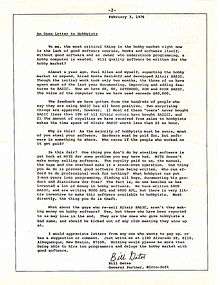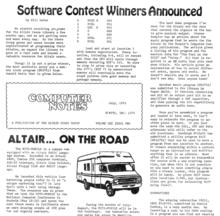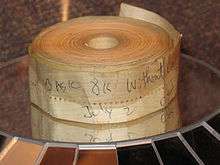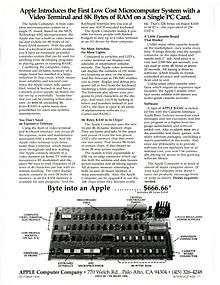Open Letter to Hobbyists

The Open Letter to Hobbyists was a 1976 open letter written by Bill Gates, the co-founder of Microsoft, to early personal computer hobbyists, in which Gates expresses dismay at the rampant copyright infringement of software taking place in the hobbyist community, particularly with regard to his company's software.
In the letter, Gates expressed frustration with most computer hobbyists who were using his company's Altair BASIC software without having paid for it. He asserted that such widespread unauthorized copying in effect discourages developers from investing time and money in creating high-quality software. He cited the unfairness of gaining the benefits of software authors' time, effort, and capital without paying them.
Altair BASIC
In December 1974 Bill Gates was a student at Harvard University and Paul Allen worked for Honeywell in Boston when they saw the Altair 8800 computer in the January 1975 issue of Popular Electronics. They had written BASIC language programs since their days at Lakeside School in Seattle and knew the Altair computer was powerful enough to support a BASIC interpreter.[1] They wanted to be the first to offer BASIC for the Altair computer and the software development tools they had previously created for their Intel 8008 microprocessor based Traf-O-Data computer would give them a head start.[2]
By early March, Paul Allen, Bill Gates, and Monte Davidoff, another Harvard student, had created a BASIC interpreter that worked under simulation on a PDP-10 mainframe computer at Harvard. Allen and Gates had been in contact with Ed Roberts of MITS and in March, 1975 Allen went to Albuquerque, New Mexico, to test the software on an actual machine. To both Paul Allen's and Ed Roberts's surprise the software worked.[3]

MITS agreed to license the software from Allen and Gates. Paul Allen left his job at Honeywell and became the Vice President and Director of Software at MITS with a salary of $30,000 per year.[4] Bill Gates was still a student at Harvard and just a contractor with MITS. The October 1975 company newsletter gives his title as "Software Specialist".[5] On July 22, 1975 MITS signed the contract with Allen and Gates. They got $3000 at the signing and a royalty for each copy of BASIC sold; $30 for the 4K version, $35 for the 8K version and $60 for the expanded version. The contract had a cap of $180,000 and MITS got an exclusive worldwide license to the program for 10 years. MITS would supply the computer time necessary for development on a PDP-10 owned by the Albuquerque school district.[6]
The April 1975 issue of MITS's Computer Notes had the banner headline "Altair Basic - Up and Running." The Altair 8800 computer was a breakeven sale for MITS. They needed to sell additional memory boards, I/O boards, and other options to make a profit. When purchased with two 4K memory boards and an I/O board the 8K BASIC was only $75. The initial standalone price for BASIC was $500.
MITS purchased a camper van and outfitted it with the complete product line. The "MITS-Mobile" team toured the United States giving seminars featuring the Altair Computer and Altair BASIC.
The Homebrew Computer Club was an early computer hobbyist club in Palo Alto, CA. At the first meeting in March, 1975 Steve Dompier gave an account of his visit to the MITS factory in Albuquerque where he attempted to pick up his order for one of everything.[7] He left with a computer kit with only 256 bytes of memory. At the April 16, 1975 club meeting Dompier keyed in a small program that played the song "Fool on the Hill" on a nearby AM radio. In the July 1975 Computer Notes, Bill Gates described this as "the best demo program I've seen for the Altair…" Gates could not figure out how the computer could broadcast to the radio.[8] (It was radio frequency interference or static controlled by the timing loops in the program.[9])
"Thieves" and "parasites"
The June 1975 Homebrew Computer Club Newsletter carried this item written by Fred Moore, Editor:
The MITS MOBILE came to Rickey's Hyatt House in Palo Alto June 5th & 6th. The room was packed (150+) with amateurs and experimenters eager to find out about this new electronic toy.[10]

At the seminar, a paper tape containing a pre-release version of Altair BASIC disappeared. The tape was given to Steve Dompier who passed it on to Dan Sokol who had access to a high speed tape punch. At the next Homebrew Computer Club meeting, 50 copies of Altair BASIC on paper tape appeared in a cardboard box.[11]
MITS offered a complete Altair system with two MITS 4K Dynamic RAM boards, a serial interface board and Altair BASIC for $995.[12] However the $264 MITS RAM boards were unreliable due to several component and design problems. An enterprising Homebrew Computer Club member, Robert Marsh, designed a 4K static memory that was plug-in compatible with the Altair 8800 and sold for $255.[13] His company was Processor Technology, one of the most successful Altair compatible board suppliers. Many Altair 8800 computer owners skipped the bundled package; purchased their memory boards from a third party supplier and used a "borrowed" copy of Altair BASIC.
Ed Roberts acknowledged the 4K Dynamic RAM board problems in the October 1975 Computer Notes. The price was reduced from $264 to $195 and existing purchasers got a $50 rebate. The full price for 8K Altair BASIC was reduced to $200. Roberts declined a customer's request that MITS give BASIC to customers for free. He noted that MITS made a "$180,000 royalty commitment to Micro Soft." Roberts also wrote, "Anyone who is using a stolen copy of MITS BASIC should identify himself for what he is, a thief." Third party hardware suppliers drew this comment; "Recently a number of parasite companies have appeared."[14]
The Processor Technology static RAM board drew more current than the MITS dynamic RAM board and two or three boards would tax the Altair 8800 power supply. Howard Fullmer began selling a power supply upgrade and named his company "Parasitic Engineering".[15][16] Fullmer later helped define the industry standard for Altair compatible boards, the S-100 bus standard.[17]
The next year, 1976, would see many Altair bus computer clones such as the IMSAI 8080 and the Processor Technology Sol 20.
Open letter
"Micro-Soft" received a $30 to $60 royalty for each copy of BASIC that MITS sold. At the end of 1975, MITS was shipping a thousand computers a month but BASIC was selling in the low hundreds.[18] There were additional software projects that required more resources. The MITS 8-inch floppy disk system was about to be released as was the MITS 680B computer based on the Motorola 6800. A high school friend of Allen and Gates, Ric Weiland, was hired to convert the 8080 BASIC to the 6800 microprocessor. Gates would attempt to explain the cost of developing software to the hobbyist community.
David Bunnell, Computer Notes Editor, was sympathetic to Gates's position. He wrote in the September 1975 issue that "customers have been ripping off MITS software".
Now I ask you--does a musician have the right to collect the royalty on the sale of his records or does a writer have the right to collect the royalty on the sale of his books? Are people who copy software any different than those who copy records and books?[19]
Gates' letter restated what Bunnell wrote in September and Roberts wrote in October. However, the tone of his letter was those hobbyists were stealing from him, not from a corporation.
Why is this? As the majority of hobbyists must be aware, most of you steal your software. Hardware must be paid for, but software is something to share. Who cares if the people who worked on it get paid?
One of the principal targets of the letter was the Homebrew Computer Club and a copy would be sent to the club. The letter would also appear in Computer Notes. To ensure the letter would be noticed, Dave Bunnell sent the letter via special delivery mail to every major computer publication in the country.[20]
In the letter Gates mentions they are writing APL for the 8080 and 6800 microprocessors. The APL programming language was in vogue with some computer scientists in the 1970s. The language uses a character set based on the Greek alphabet that required special terminals. Most hobbyist terminals did not display lower case letters much less Greek symbols. Gates was enamored with APL but Allen did not think they could sell this product. The interest in APL project faded and software was never written.[21]
Reaction

The letter was noticed and the reaction was strong. Many felt the software should be bundled with the machine and the current distribution method was Gates' problem. Others questioned the cost of developing software.
Microsoft had already addressed the royalty issue; MITS would pay a fixed price, $31,200, for a non exclusive license for the 6800 BASIC.[22] The future sales of BASIC for the Commodore PET, the Apple II, the Radio Shack TRS-80 and others were all fixed-price contracts.[23]
In early 1976 ads for its Apple I computer, Apple Inc made the claims that "our philosophy is to provide software for our machines free or at minimal cost"[24] and "yes folks, Apple BASIC is Free".[25]
Microsoft's software development was done on a DEC PDP-10 mainframe computer system. Paul Allen had developed a program that could completely simulate a new microprocessor system. This allowed them to write and debug software before the new computer hardware was complete. They were charged by the hour and by the amount of resources used (storage, printing, etc.) The 6800 BASIC was complete before the Altair 680 was finished.[26] This was the $40,000 of computer time mentioned in the letter.
Hal Singer of the Micro-8 Newsletter published an open letter to Ed Roberts of MITS. Hal pointed out that MITS promised a computer for $395 but the price for a working system was $1000. He suggested a class action lawsuit or a Federal Trade Commission investigation into false advertising was in order. Hal also noted that rumors were circulating that Bill Gates developed BASIC on a Harvard University computer that was funded by the US government. Why should customers pay for software already paid for by the taxpayer?[27]
Bill Gates, Paul Allen, and Monte Davidoff did use a PDP-10 at Harvard's Aiken Computer Center. The computer system was funded by the Department of Defense through its Defense Advanced Research Projects Agency. Harvard officials were not pleased that Gates and Allen (who was not a student) had used the PDP-10 to develop a commercial product, but determined that this military computer was not covered by any Harvard policy; the PDP-10 was controlled by Professor Thomas Cheatham, who felt that students could use the machine for personal use. Harvard placed restrictions on the computer's use, and Gates and Allen had to use a commercial time share computer in Boston to finalize the software.[28]
In 2008, Homebrew member Lee Felsenstein recalled similar doubts about Gates' $40,000 number: "Well, we all knew [that] the evaluation of computer time was the ultimate in funny money. You never pay that much for the computer time and I think that research will show that they were using someone else's computer time; someone else was paying for that. It could have been Honeywell where Paul Allen was working. So we all knew this to be a spurious argument."[29]
According to Felsenstein, Gates' letter "delineated a rift [between] the actual industry where there's trying to make money and there's those hobbyist where we're trying to make things happen", whereas
The industry needs the hobbyists and this was illustrated by what happened eventually. When National Semiconductor, which made their own microprocessor chips in '77 or '78, decided they needed a BASIC [...] they asked, 'What's the most popular BASIC?' And the answer was Microsoft BASIC because everybody had copied it and everybody was using it. So we made Microsoft the standard BASIC. National Semiconductor went to Microsoft and bought a license, they were in business that way. This was the marketing function and the hobbyists did the marketing with a complete antipathy of the company in question. There were other BASICs and, you know, some of them might even have been better. [...] [Gates' later success] was in a certain measure because of what we did, that he said we shouldn't do, we were thieves to do it, and all."[29]
There is a viable alternative to the problems raised by Bill Gates in his irate letter to computer hobbyists concerning "ripping off" software. When software is free, or so inexpensive that it's easier to pay for it than to duplicate it, then it won't be "stolen".
Jim Warren, July 1976 [30]
Jim Warren, Homebrew Computer Club Member and editor of Dr. Dobb's Journal, wrote in the July 1976 ACM Programming Language newsletter about the successful Tiny BASIC project.[30] The goal was to create BASIC language interpreters for microprocessor based computers. The project had started in late 1975 but the "Open Letter" motivated many hobbyists to participate. Computer clubs and individuals from all parts of the United States and the world soon created Tiny BASIC interpreters for the Intel 8080, the Motorola 6800 and MOS Technology 6502 processors. The assembly language source code was published or the software was sold for five or ten dollars.
Magazines that published the letter
- Gates, Bill (January 1976). "An Open Letter To Hobbyists". Homebrew Computer Club Newsletter. Mountain View, CA: Homebrew Computer Club. 2 (1): 2.
- Gates, Bill (February 10, 1976). "An Open Letter To Hobbyists". Micro-8 Computer User Group Newsletter. Lompoc, CA: Cabrillo Computer Center. 2 (2): 1.
- Gates, Bill (February 1976). "An Open Letter To Hobbyists". Computer Notes. Albuquerque, NM: MITS. 1 (9): 3. Archived from the original on March 23, 2012.
- Gates, Bill (March 11, 1976). "An Open Letter to Hobbyists". Minicomputer News. Boston MA: Benwill Publishing.
- Gates, Bill (March–April 1976). "An Open Letter To Hobbyists". People's Computer Company. Menlo Park, CA: People's Computer Company. 4 (5).
- Gates, Bill (May 1976). "Computer Hobbyists". Radio-Electronics. Vol. 47 no. 5. New York NY: Gernsback Publications. pp. 14, 16.
Several responses to the letter were published, including one from Bill Gates.
- Hayes, Mike (February 1976). "Regarding Your Letter of February 3". Homebrew Computer Club Newsletter. Mountain View, CA: Homebrew Computer Club. 2 (2): 2. Retrieved November 25, 2007.
- Singer, Harold L. (March 28, 1976). "An Open Letter to Ed Roberts". Micro-8 Computer User Group Newsletter. Lompoc, CA: Cabrillo Computer Center. 2 (4): 1.
- Gates, Bill (April 1976). "A Second and Final Letter". Computer Notes. Albuquerque, NM: MITS. 1 (11): 5. Archived from the original on March 23, 2012.
- Childs, Art (May 1976). "Interfacial". SCCS Interface. Los Angeles: Southern California Computer Society. 1 (6): 2, 4. Editor Art Childs writes about the letter he received from the "author of Altair Basic" and the resulting controversy on propriety software.
- Wada, Robert (July 1976). "An Opinion on Software Marketing". BYTE. Vol. 1 no. 11. Peterborough, NH: BYTE Publications. pp. 90, 91.
- Warren, Jim C. (July 1976). "Correspondence". SIGPLAN Notices. ACM. 11 (7): 1. Jim Warren, the editor of Dr. Dobbs Journal, describes how the Tiny BASIC project is an alternative to hobbyist "ripping off" software.
- Moores, Calvin (September 1976). "Are you an author?". BYTE. Vol. 1 no. 13. Peterborough, NH: BYTE Publications. pp. 18–22. An article on software copyright law that discusses the "Open Letter to Hobbyists".
Notes
- ↑ The January 1975 issue of Popular Electronics was published on November 29, 1974. File:Copyright Popular Electronics 1975.jpg
- ↑ Manes (1994), 68–70.
- ↑ Manes (1994), 65–76.
- ↑ Young (1998), 164.
- ↑ "Contributors". Computer Notes. Albuquerque NM: MITS. 1 (5): 13. October 1975. Archived from the original on March 23, 2012.
- ↑ Manes (1994), 82–83.
- ↑ Freiberger (2000), 52–53.
- ↑ Gates, Bill (July 1975). "Software Contest Winners Announced". Computer Notes. Albuquerque NM: MITS. 1 (2): 1. Archived from the original on March 23, 2012.
- ↑ Dompier, Steve (February 1976). "Music of a sort". Dr. Dobbs Journal. Menlo Park CA: People's Computer Company. 1 (2): 6–7.
- ↑ Moore, Fred (June 7, 1975). "It's a Hobby". Homebrew Computer Club Newsletter. 1 (4): 1.
- ↑ Manes (1994), 81.
- ↑ MITS (August 1975). "Worlds Most Inexpensive BASIC language system". Radio-Electronics. Vol. 46 no. 8. p. 1. MITS advertisement File:Altair Computer Ad August 1975.jpg
- ↑ "Hardware". Homebrew Computer Club Newsletter. 1 (5): 2, 5. July 5, 1975.
- ↑ Roberts, H. Edward (October 1975). "Letter from the President". Computer Notes. Albuquerque NM.: MITS. 1 (5): 3–4. Archived from the original on March 23, 2012.
- ↑ Freiberger (2000), 145–146.
- ↑ Ahl, David H.; Burchenal Green (April 1980). "Saga of a System (Building an Altair 8800/Cromemco TV Dazzler system)". The Best of Creative Computing, Volume 3. Morristown NJ: Creative Computing. pp. 90–97. ISBN 0-916688-12-7. David Ahl describes the assembly of an Altair 8800 system and the various problems that were encountered. The Processor Technology 8K Static RAM (page 94) and the Parasitic Engineering power supply (page 97) are used to replace the MITS components in his system.
- ↑ Morrow, George; Howard Fullmer (May 1978). "Microsystems Proposed Standard for the S-100 Bus Preliminary Specification, IEEE Task 696.1/D2". Computer. IEEE. 11 (5): 84–90. doi:10.1109/C-M.1978.218190.
- ↑ Manes (1994), 90.
- ↑ Bunnell, David (September 1975). "Across the Editor's Desk". Computer Notes. Albuquerque NM.: MITS. 1 (4): 2. Archived from the original on March 23, 2012.
- ↑ Manes (1994), 91.
- ↑ Manes (1994), 97–98.
- ↑ Manes (1994), 95.
- ↑ Manes (1994), Commodore, page 105. Apple $21,000, page 111. Radio Shack $50,000, page 114. Other companies "roughly $35,000 per license", page 105.
- ↑ "The Apple 1 Project".
- ↑ "Apple I Computer Ad".
- ↑ Roberts, Ed (March 1976). "Ramblings from Ed Roberts". Computer Notes. Albuquerque, NM: MITS. 1 (10): 4. Archived from the original on March 23, 2012.The 680 hardware was months late. Roberts reported. "We now have a full up 8K BASIC operational…"
- ↑ Singer, Harold L. (March 28, 1976). "Open Letter to Ed Roberts". Micro-8 Computer User Group Newsletter. Lompoc, CA: Cabrillo Computer Center. 2 (4): 1.
- ↑ Wallace (1992), 81–83. "Harvard officials had found out that he (Gates) and Allen had been making extensive use of the university's PDP-10 to develop a commercial product. The officials were not pleased." The computer was funded by the Department of Defense and was under the control of Professor Thomas Cheatham. "Although DARPA was funding the PDP-10 at Harvard, there was no written policy regarding its use. ... After the computer flap, Gates and Allen bought computer time from a timesharing service in Boston to put the finishing touches on their BASIC."
- 1 2 Oral History of Lee Felsenstein. Interviewed by Kip Crosby. Computer History Museum 2008, CHM Reference number: X4653.2008
- 1 2 Warren, Jim C. (July 1976). "Correspondence". SIGPLAN Notices. ACM. 11 (7): 1–2. ISSN 0362-1340.
See also
References
- Ceruzzi, Paul E. (2003). A History of Modern Computing. Cambridge, MA: MIT Press. ISBN 0-262-53203-4.
- Freiberger, Paul; Swaine, Michael (2000). Fire in the Valley: The Making of the Personal Computer. New York, NY: McGraw-Hill. ISBN 0-07-135892-7.
- Manes, Stephen; Paul Andrews (1994). Gates: How Microsoft's Mogul Reinvented an Industry and Made Himself the Richest Man in America. New York: Touchstone, Simon and Schuster. ISBN 0-671-88074-8.
- Wallace, James; Jim Erickson (1992). Hard Drive: Bill Gates and the Making of the Microsoft Empire. John Wiley & Sons. ISBN 0-471-56886-4.
- Young, Jeffrey S. (1998). Forbes Greatest Technology Stories: Inspiring Tales of the Entrepreneurs. New York: John Wiley & Sons. ISBN 0-471-24374-4. Chapter 6 "Mechanics: Kits & Microcomputers"
External links
- The letter in HTML format
- Reproduction of the letter as it appeared in Computer Notes Volume 1 Issue 9 - February, 1976
- Reproduction of the letter as it appeared in the Homebrew Computer Club Newsletter Volume 2, Issue 1, January 31, 1976 (letter dated February 3)
